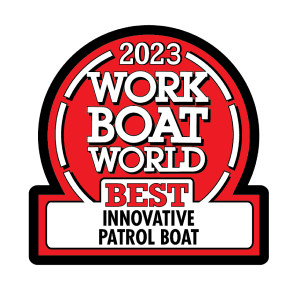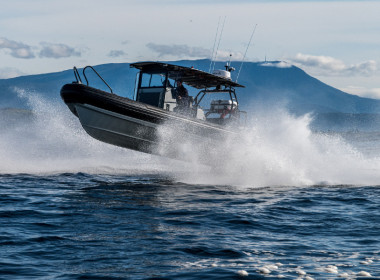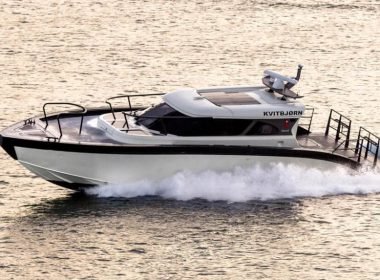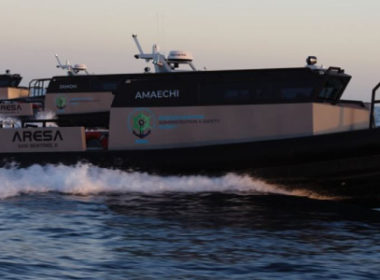AWARDS 2023 | Innovative Patrol Boat – Matawha – One2three Naval Architects & Sentinel Boats

Innovative Patrol Boat – Matawha – One2three Naval Architects & Sentinel Boats

These impressively versatile and innovative patrol/workboats were recently delivered to the Royal New Zealand Navy by their Tasmanian builder Sentinel Boats. Classed by the navy, in typically clumsy naval parlance, as littoral manoeuvre craft (LMC), they are, given their intended roles, revolutionary.
Constructed of high density polyethylene (HDPE) they are, at 12.6 metres LOA, large for that material. However, HDPE is a near perfect construction material for such craft and Sentinel Boats and designer One2three naval architects have considerable experience with the medium. The boats look the part and offer an excellent example of Australasian defence cooperation.
“They are our first serious naval platforms and it has been a very successful design build and deliver program with fantastic customer input and support,” Steve Quigley, One2Three Naval Architects Managing Director, told Baird Maritime. “They are true multi-purpose vessels, made challenging by the breadth of roles required to be filled, including carrying a daughter craft, and launching via a system on such a small platform.”
“We considered the capability the Royal New Zealand Navy required from these vessels and worked closely with One2three to create something unique,” added Sentinel Boats CEO George McGuire. “Achieving the embarked 5.5-metre daughter craft requirement in a 12.5-metre, 40-knots plus multi-role vessel that can be launched and recovered from boat davits on the RNZN’s support ships is no small achievement!”
McGuire praised the matching of the design with the properties of a handbuilt HDPE craft. A final set of acceptance trials in Auckland Harbour proved that the boats can handle well even at speed and in choppy conditions.
“As with all custom builds, ensuring that the littoral mission craft (LMC) met the highly specialised and demanding specifications of the RNZN required intensive communication and ongoing refinement. Mutual respect and openness with each other was key.”
McGuire said that as the tender launch and recovery system is rarely seen in a vessel of this size, it required clever thinking in terms of the design from One2three and in deck space optimisation. Considerable time was then spent working on the engine and waterjet geometry and ensuring everything fit into the hull to achieve the sloped engine covers to facilitate the launch and recovery of the smaller rigid inflatable boat (RIB).
“We worked extremely closely with the RNZN’s project team and the end result is a testament to what can be achieved when you engage in true partnership with a client.”
In Quigley’s view, meanwhile, delivering an innovative design is always challenging, particularly as adding a concurrent commercial and naval certification process to a relatively new material (i.e. HDPE) in terms of certification and military usage made for a complex but rewarding outcome.
“Our primary take-away from the project has been the importance of integrating all stakeholders into the design process, supported by rigorous documentation at the earliest possible stage, and then maintaining that collaborative effort throughout the build.”
For Quigley, autonomous and remote operated operations are trending topics in the maritime security industry.
“Our HDPE vessel technology with its robust and anti-magnetic properties combined with our autonomy partners’ technology will be compelling to most security organisations,” he told Baird Maritime. “We have therefore made a conscious strategic decision to invest heavily in alternative fuels, high-strength HDPE, and autonomous technology.”
McGuire believes there will be growth in the maritime security industry in response to what is happening in the waters around Australia, New Zealand, and near-neighbours across the South West Pacific region.
“Autonomy offers the ability to dramatically increase the on-water presence for maritime security forces, which, in turn, allows them to better understand what is happening and respond quickly to any issues. Response is more likely to be via crewed vessel – so I am not saying that all assets in the mix will be autonomous – but they will be increasingly prevalent around our coasts, in our ports and our major approach corridors.
“With autonomy resulting in increased on-water/at-sea time for an individual platform, the benefits of acquiring HDPE boats comes to the fore. In particular, the longevity, as there’s no risk of corrosion or degradation from electrolysis or water ingress to an FRP lay-up once the vessel has the inevitable impacts with objects over time. Impact resistance is another benefit.
McGuire added that there is an increasing focus on environmental sustainability. This will see the ongoing development of both hybrid and fully electric or hydrogen propulsion systems.
“Interestingly, sustainability is an area where HDPE also has many benefits. Once again, HDPE’s longevity means that a heavy use operator, such as the aquaculture industry, does not need to replace their boats every 10 years. We have boats that have been in operational service with this industry for over 27 years and still going strong after five sets of new engines!”
McGuire commented that HDPE is also fully recyclable, allowing the material to be used in a vessel for 40 or even 50 years.
“Regarding the Australian workboat industry,” he said, “advances in propulsion will be key in buyer’s minds. Customers want to know when a piece of technology is mature enough to be reliable as well as when the operational benefits will outweigh any limitations. Hull design is also part of the sustainability equation and we are lucky enough to work closely with the team at One2three, as they learn from their activities across many market segments.”
“Workboats in Australia are working harder than ever before especially in the offshore aquaculture and para-military domains,” said Quigley. “As workplaces extend further offshore, the demand for higher speeds, increased range, and the ability to remain at the workplace for extended periods is posing challenges to traditional design practices. Our designs now therefore leverage high-speed vessel experience and advanced design tools including CFD and finite element analysis to optimise these boats without compromising robustness and the ability to perform under tough and unrelenting conditions.
Quigley added that One2three anticipates a rapid acceleration in the demand for HDPE platforms due to their physical toughness, extreme resistance to sinking (as the material is lighter than water), and their noise-, vibration- and fatigue-absorbing properties.
“The polyethylene material increases safety and delivers first responders and critical personnel ‘task ready’, and not fatigued from the transit.”
The previous year was a busy one for both One2three and Sentinel Boats. Quigley said that there is a significant rebound post-Covid in both the tourism and commuter markets, as reflected in enquiry levels and new boat contracts signed, leading to optimism about the future.
“The year 2023 was also a transformative year for Sentinel Boats,” added McGuire. “After 30 years building boats under the PFG Group, Sentinel Boats was launched as a standalone entity to allow us to focus on bringing the significant longevity, impact resistance, and ease of maintenance benefits of HPDE-manufactured boats to clients.
The benefits are really magnified in high-use or demanding operational scenarios. For that reason, the majority of Sentinel Boats’ clients come from defence, law enforcement, rescue, and government services as well as commercial operators.
“I am very optimistic about the future as more and more people and organisations are starting to understand the whole of life savings and operational benefits of a quality HDPE boat,” McGuire told Baird Maritime. “In particular, I think the RNZN LMC project opened many people’s eyes to what our company can do.”
For a list of the 2023 “Best Of” award winners, please click here.











